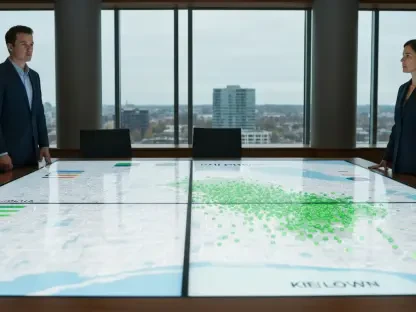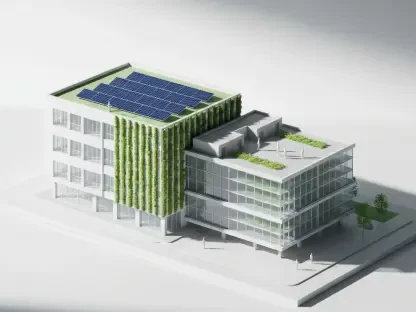Nestled in the foothills of the Trans-Ili Alatau mountains in Kazakhstan, a remarkable architectural project is redefining contemporary residential design by revisiting ancient building practices. This cob house serves as a testament to how sustainable living can intersect with innovative design, focusing on organic shapes and natural materials. The movement toward sustainability is enriched by this home’s unique architectural approach, demonstrating how ancient methods can align with modern ecological sensibilities to challenge conventional norms and promote harmony with the environment.
A New Approach to Residential Architecture
Inspiration from Middle-earth and Beyond
In the rugged Alatau region of Kazakhstan, a house emerges that encapsulates the ethereal charm of Tolkien’s Middle-earth and the cavelike villas envisioned by Jacques Couëlle. This architectural marvel embodies an imaginative blend of ancient methods and modern eco-friendly design philosophies. It stands amid nature, echoing structures from fantastical realms while embracing the authenticity of age-old construction techniques. The spectacular landscape itself inspires the residence’s organic lines and shapes, forging a direct and respectful relationship with the environment. From the sturdy walls to the undulating rooflines, each element evokes a balance between nature and nurturing, transforming the home into a living piece of art. This visionary approach showcases the possibility of integrating ancient methods with contemporary sensibilities to create sustainable, aesthetically captivating structures.
Combining Ancient Methods with Modern Sensibilities
Reviving the age-old technique of cob construction, this distinctive house exemplifies a commitment to sustainability through the use of natural materials such as clay, sand, straw, and water. Cob construction minimizes waste and promotes energy efficiency, revealing how traditional methods can serve modern ecological goals. By harnessing locally sourced materials, the couple behind the project has crafted a residence that harmonizes with its surroundings and embodies ecological principles. The house’s sculptured contours emphasize a seamless integration of form and function, reinforcing the bond between the dwelling and the landscape. The cob method enables this structure to become a self-insulating entity, maintaining optimal indoor temperatures and reducing reliance on conventional energy sources. The organic footprint of the cob house further illustrates how embracing natural building processes can lead to elegant residential architecture, fostering a symbiotic relationship with the land.
The Visionary Duo Behind the Project
From Legal Careers to Architectural Pioneers
Dilyara Mazhitova and Vladimir Radostovets transitioned from practicing law to championing innovative architecture rooted in sustainability. Their passion for ecologically responsible living inspired them to embark on a transformative journey, where they honed their skills and established themselves as leaders in sustainable design. Moving beyond their established legal careers, the couple immersed themselves in the exploration of construction techniques that prioritize environmental stewardship. Through this venture, Mazhitova and Radostovets have evolved into pioneers of eco-friendly living, integrating their diverse talents to craft a unique architectural narrative. Their shift from law to environmental architecture illustrates the power of pursuing one’s passion and the potential impact of such a transition on broader societal movements toward sustainability.
From Passion Project to Pioneering Movement
Mazhitova and Radostovets devoted over a decade to refining their vision, allowing this cob house to evolve into an artful representation of modern residential architecture. The extended timeline granted them the license to experiment and explore innovative ideas, consequently pushing the boundaries of sustainable design. As they sculpted and refined their masterpiece, new inspirations and creative solutions emerged, reinforcing their dedication to the pursuit of environmental harmony and artistic excellence. This creative process fostered a pioneering movement in architecture marked by unique creativity and a focus on ecological integration. By embracing this experimental journey, they have crafted an abode that stands as a testament to artistic expression through sustainable practices, inspiring other visionaries to explore the architectural potential inherent in repurposing age-old methods.
Sustainable Living Meets Artistic Expression
Merging Functionality with Aesthetic Beauty
Each aspect of the cob house, from its rippling rooflines to organically integrated furniture, exemplifies the fusion of functionality and artistic expression. Thoughtfully placed windows and skylights offer abundant natural light, enhancing both form and purpose by optimizing daylight penetration throughout the dwelling. This strategic incorporation of light elevates the aesthetic quality of the home while also ensuring optimal energy effectiveness and environmental adaptation. The careful consideration given to every architectural element underscores the commitment to creating a space that is not only visually appealing but also eco-conscious in its design. Earth-inspired textures, shapes, and surfaces seamlessly merge to form an abode resonant with nature’s beauty, illustrating the capacity for artistic design to coexist with sustainable principles.
The Art of Crafting an Eco-friendly Home
By selecting materials such as naturally fallen timbers and locally sourced resources, Mazhitova and Radostovets reaffirm their dedication to holistic and sustainable architectural practices. Throughout the construction process, ecological considerations took precedence, resulting in a harmonious integration between the home and the surrounding landscape. The cob house achieves an aesthetic coherence that complements and respects its environment, functioning as a living expression of sustainable artistry. Such choices reflect the couple’s unwavering commitment to conscientious building practices, where every design decision resonates with the ecological footprint. This mindful crafting process culminates in a residence that stands as an emblem of environmental consciousness and aesthetic beauty, inspiring other architects to explore the multidimensional possibilities of sustainability.
Innovative Solutions to Design Challenges
Overcoming Barriers with Creativity
The journey toward building this unique cob house was marked by various design challenges, yet the couple overcame them with inventive solutions that marry tradition with contemporary innovation. Utilizing geo-synthetic materials in the roof construction ensures structural integrity while supporting natural growth and erosion prevention. These practical applications of ancient techniques reveal how creativity and innovation can enhance architectural designs, providing robust solutions to modern-day problems. By leveraging the durability and versatility inherent in cob construction alongside innovative materials, Mazhitova and Radostovets exemplify the power of merging ancient methods with modern design advancements. The creative exploration inherent in overcoming such barriers reflects a dedication to environmental integration and ensures the house remains a sustainable structure now and into the future.
A Journey of Learning and Discovery
Tucked away in the gentle slopes of Kazakhstan’s Trans-Ili Alatau mountains lies a unique architectural initiative that is reshaping modern residential design by drawing inspiration from ancient building traditions. This cob house stands as a powerful symbol of how sustainable living can merge seamlessly with innovative design. By emphasizing organic shapes and the use of natural materials, this architectural marvel highlights the growing movement toward sustainable practices. It showcases how time-honored construction techniques can be harmoniously integrated with contemporary ecological ideas. This approach defies standard design principles, encouraging a deeper connection with our natural environment. The project is not just about creating a dwelling; it’s a bold statement that challenges existing norms, aiming to foster a sense of unity with nature. By bridging the gap between the old and the new, this cob house sets a precedent for future designs that prioritize environmental stewardship alongside modern living.









